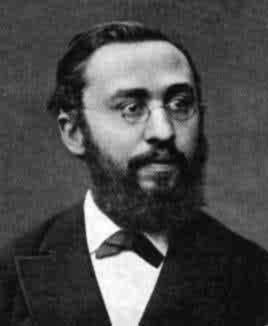


 تاريخ الرياضيات
تاريخ الرياضيات
 الرياضيات في الحضارات المختلفة
الرياضيات في الحضارات المختلفة 
 الرياضيات المتقطعة
الرياضيات المتقطعة
 الجبر
الجبر
 الهندسة
الهندسة 
 المعادلات التفاضلية و التكاملية
المعادلات التفاضلية و التكاملية 
 التحليل
التحليل
 علماء الرياضيات
علماء الرياضيات |
Read More
Date: 3-3-2017
Date: 28-2-2017
Date: 25-2-2017
|
Died: 4 February 1928 in Haarlem, Netherlands

Hendrik Lorentz attended Mr Timmer's Primary School in Arnhem until he was 13 years of age when he entered the new High School there. He entered the University of Leiden in 1870 but, in 1872, he returned to Arnhem to take up teaching evening classes. He worked for his doctorate while holding the teaching post.
Lorentz refined Maxwell's electromagnetic theory in his doctoral thesis The theory of the reflection and refraction of light presented in 1875. He was appointed professor of mathematical physics at Leiden University in 1878. He remained in this post until he retired in 1912 when Ehrenfest was appointed to his chair. After retiring from this chair, Lorentz was appointed director of research at the Teyler Institute, Haarlem. However, he retained an honorary position at Leiden, where he continued to lecture.
Before the existence of electrons was proved, Lorentz proposed that light waves were due to oscillations of an electric charge in the atom. Lorentz developed his mathematical theory of the electron for which he received the Nobel Prize in 1902. The Nobel prize was awarded jointly to Lorentz and Pieter Zeeman, a student of Lorentz. Zeeman had verified experimentally Lorentz's theoretical work on atomic structure, demonstrating the effect of a strong magnetic field on the oscillations by measuring the change in the wavelength of the light produced.
Lorentz is also famed for his work on the FitzGerald-Lorentz contraction, which is a contraction in the length of an object at relativistic speeds. Lorentz transformations, which he introduced in 1904, form the basis of Einstein's special theory of relativity. They describe the increase of mass, the shortening of length, and the time dilation of a body moving at speeds close to the velocity of light.
Lorentz was chairman of the first Solvay Conference held in Brussels in the autumn of 1911. This conference looked at the problems of having two approaches, namely that of classical physics and of quantum theory. However Lorentz never fully accepted quantum theory and always hoped that it would be possible to incorporate it back into the classical approach. He said in his presidential address at the opening ceremony of the conference:-
In this stage of affairs there appeared to us like a wonderful ray of light the beautiful hypothesis of energy elements which was first expounded by Planck and then extended by Einstein and Nernst, and others to many phenomena. It has opened for us unexpected vistas, even those, who consider it with a certain suspicion, must admit its importance and fruitfulness.
Some of Lorentz's numerous publications are highlighted in [3]:-
In an early memoir, which became famous, Lorentz applied for the first time considerations relating to discrete molecules to electric propagation in material bodies, and incidentally arrived at a rational reflection-equivalent for each substance independent of its density. In 1884 he began to study the effect which magnetization exerts on the polarization of reflected light. His "Théorie Electromagnétique de Maxwell et son application auz Corps Mouvants" and his "Versuch einer Theorie der Elektrischen und Optischen Erscheinungen in bewegten Körpern" were published in 1892 and 1895respectively. They embodied the first systematic appearance of the electrodynamic principle of relativity, and in 1920 he brought out "The Einstein Theory of Relativity: A Concise Statement". In 1909 he published his "Theory of Electrons", based on a series of lectures at Columbia University, and in1916 he published in French at Leipzig an account of statistical thermodynamic theories, based on lectures delivered at the Collège de France in 1912. An edition of his University lectures, entitled "Lessons on Theoretical Physics", began to appear, under his supervision, in 1919. He was also the author of a textbook of the differential and integral calculus; "Visible and Invisible Movements", 1901; and "Clerk Maxwell's Electromagnetic Theory", 1924.
In [7] O W Richardson describes Lorentz as:-
... a man of remarkable intellectual powers ... . Although steeped in his own investigation of the moment, he always seemed to have in his immediate grasp its ramifications into every corner of the universe. ... The singular clearness of his writings provides a striking reflection of his wonderful powers in this respect. .... He possessed and successfully employed the mental vivacity which is necessary to follow the interplay of discussion, the insight which is required to extract those statements which illuminate the real difficulties, and the wisdom to lead the discussion among fruitful channels, and he did this so skilfully that the process was hardly perceptible.
Lorentz received a great many honours for his outstanding work. He was elected a Fellow of the Royal Society in 1905. The Society awarded him their Rumford Medal in 1908 and their Copley Medal in 1918.
The respect in which Lorentz was held in The Netherlands is seen in Richardson's description of his funeral [7]:-
The funeral took place at Haarlem at noon on Friday, 10 February. At the stroke of twelve the State telegraph and telephone services of Holland were suspended for three minutes as a revered tribute to the greatest man Holland has produced in our time. It was attended by many colleagues and distinguished physicists from foreign countries. The President, Sir Ernest Rutherford, represented the Royal Society and made an appreciative oration by the graveside.
Books:
Articles:



|
|
|
|
لصحة القلب والأمعاء.. 8 أطعمة لا غنى عنها
|
|
|
|
|
|
|
حل سحري لخلايا البيروفسكايت الشمسية.. يرفع كفاءتها إلى 26%
|
|
|
|
|
|
|
جامعة الكفيل تحتفي بذكرى ولادة الإمام محمد الجواد (عليه السلام)
|
|
|